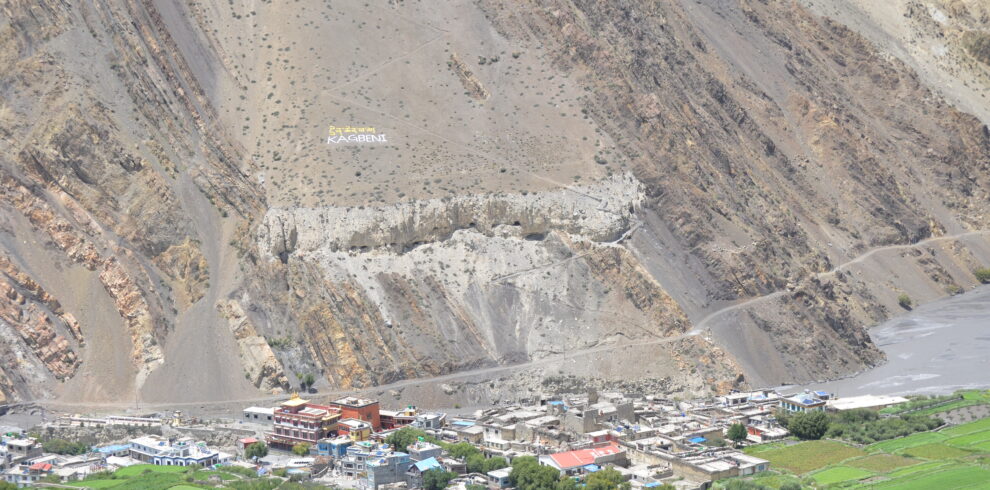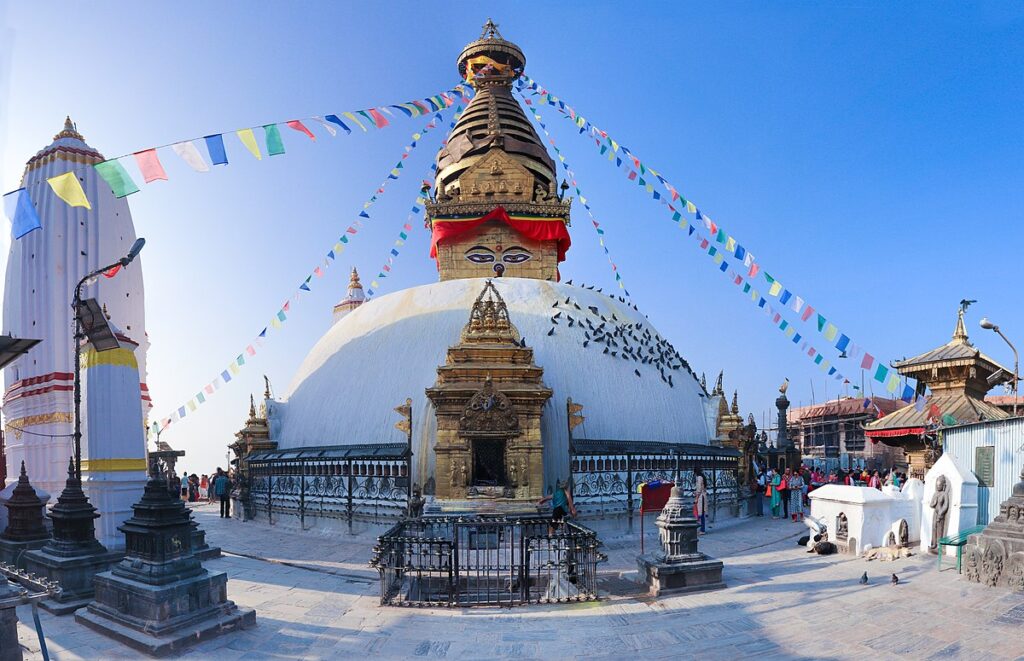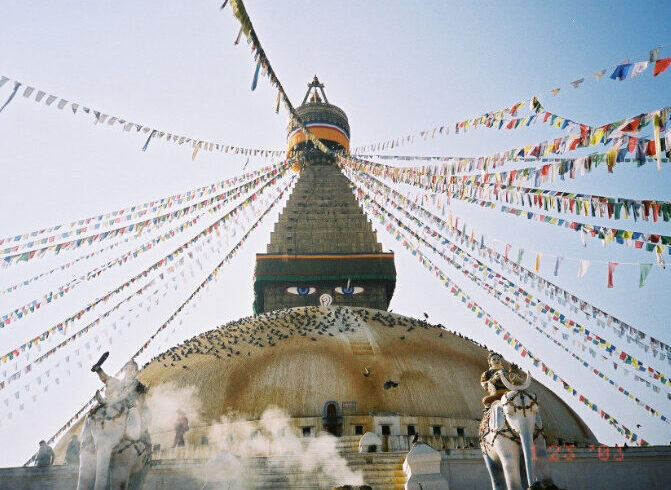Overview
Nestled in the folds of the Eastern Himalayas, remaining in self-imposed isolation for centuries, Bhutan opened up to the world in a glacial pace. The population lived in close harmony with nature, evolving a unique identity, derived largely from a rich religious and cultural heritage.This country of 700,000 people, roughly the size of Switzerland, is the world’s only Mahayana Buddhist country. The Buddhist respect for all sentient beings helped Bhutan protect its pristine ecology and wildlife. This self-sufficient population was never colonized and had limited contact to the outside world. Buddhism was established in the 8th century by the Indian saint Padmasambhava, popularly known in the Tantric tradition as Guru Rinpoche. Perhaps the most dynamic era in Bhutanese history came in the 17th century with the arrival, in 1616, of ZhabdrungNgawangNamgyal, the great leader of the Drukpa school of Mahayana Buddhism. He unified the country and established the foundations for national governance and the Bhutanese identity. In 1907, a historic Assembly of the clergy, the official administration, and the people unanimously elected GongsarUgyenWangchuck as the first hereditary King of Bhutan thus beginning the glorious era of the Wangchuck dynasty. In 2006, the fourth king of Bhutan, JigmeSingyeWangchuck announced that he would abdicate in favor of a constitutional monarchy with a parliamentary democracy. In 2008, the year that marked 100 years of the monarchy saw two important events; the first democratic elections and the coronation of the fifth king, JigmeKhesarNamgyelWangchuck.
Tour Plan
The flight to Paro is one of the most spectacular in entire Himalayas. Flying along the Himalayan range from Kathmandu or over the foothills from Kolkata, the journey offers fascinating views and an exciting descent into the Kingdom. Bhutan’s first gift, as you disembark from the aircraft will be cool, clean fresh mountain air. After immigration formalities and baggage collection, you will be met by our representative, and transfer to hotel for check-in. Later in the day after checking into hotel, proceed to visit Ta Dzong, originally built as Watchtower, which now houses National Museum. The extensive collection includes antique Thangkha paintings, textiles, weapons & armor, household objects and a rich assortment of natural and historic artifacts. Then walk down the trail to visit RinpungDzong, meaning (“fortress of the heap of jewels”), which has a long and fascinating history. Along the wooden galleries lining the inner courtyard are fine wall paintings illustrating Buddhist lore such as four friends, the old man of long life, the wheel of life, scenes from the life of Milarepa, Mount. Sumeru and other cosmic Mandala. Overnight at the hotel in Paro
After breakfast excursion to Taktshang Monastery or Tiger’s Nest (approx. 5 hours walk): It is one of the most famous of Bhutan’s monasteries, perched on the side of a cliff 900m above the Paro valley floor. It is said that Guru Rinpoche arrived here on the back of a tigress and meditated at this monastery and hence it is called ‘Tiger’s Nest’. This site has been recognised as a most sacred place and visited by ShabdrungNgawangNamgyal in 1646 and now visited by all Bhutanese at least once in their lifetime. On 19 April, 1998, a fire severely damaged the main structure of building but now this Bhutanese jewel has been restored to its original splendour. Afternoon drive to DrukgyelDzong, a ruined fortress where Bhutanese warriors fought Tibetan invaders centuries ago. The snowy dome of sacred Chomolhari, "mountain of goddess'' can be seen in all her glory from the approach road to the Dzong. Evening, visit the 7th century KyichuLhakhang, one of the 108 temples built in the Himalayas by Tibetan King, SongtsenGampo. The building of this temple marks the introduction of Buddhism in Bhutan. Overnight at the hotel in Paro.
After breakfast drive to Thimphu, the capital town of Bhutan with enroute stop at Chuzom, the confluence of Thimphu and Paro rivers. Three different style of stupas; Tibetan, Nepalese and Bhutanese adorn this confluence. Shortly before reaching Chuzom, you will see on your left TschogangLhakhang, “the temple of the excellent horse”. It is a private temple, built in 15th century, as the result of visitation from Balaha, the excellent horse, a manifestation of Chenrezig, the compassionate Buddha. On arrival in Thimphu; Check-into the hotel. The capital town of Bhutan and the centre of Government, religion and commerce, Thimphu is a unique city with unusual mixture of modern development alongside ancient traditions. With the population of about 90,000 it is perhaps still the world’s only capital city without a traffic light. Later visit to Trashichhoedzong: This impressive fortress/monastery houses Secretariat building, the throne room of His Majesty, the King and various government offices. It is also the summer residence of Chief Abbot and central monk body. King's Memorial Chorten continuously circumambulated by people, murmuring mantras and spinning their prayer wheels. Construction of this landmark was the idea of Bhutan’s third king, His Majesty JigmeDorjiWangchuk (“the father of modern Bhutan”) who has wished to erect monument to world peace and prosperity. Completed in 1974 after his untimely death, it serves both as a memorial to the Late King and as a monument to peace. Afterwards visit to Buddha Point (KuenselPhodrang). Located at a short drive from Thimphu city centre, visitors can get a good overview of the Thimphu valley from the Buddha point (KuenselPhodrang). You can pay your obeisance and offer prayers to the Buddha, the largest statue in the country and then walk around and take a glimpse of the valley. Evening an exploratory walk around Thimphu Main Street and market area. Also visit the Local Crafts Bazaar, to browse through example of Bhutan's fine traditional arts. Here you can buy hand-woven textiles, Thangkha paintings, masks, ceramics, slate and wood carvings, jewellery, interesting items made from local materials. Overnight at the hotel in Thimphu.
After breakfast, check-out from the hotel & drive Gangtey (Phobjikha) enroute visiting Dochula Pass (Altitude 3080m). In Bhutan, the passes are marked by a large Bhutanese Chorten and prayer flag. Dochula pass offers the most spectacular view over the high peaks of the eastern Himalayas on a clear day. And also via WangduePhodrang, where you can visit the local market and explore newly developed town. The district of WangduePhodrang is also famous for its bamboo products, slate and stone carvings. Further ahead pass through dense forests and oak, rhododendron tress, reaching at Gangtey (Phobjikha).Visit GangteyGoempa. Perched on a small hill that rises from the valley floor, the Gangtey Monastery is the only Nyingmapa monastery on the western side of the Black Mountain’s and also the biggest Nyingmapa monastery in Bhutan. The Monastery is surrounded by a large village inhabited mainly by the families of the 140 Gomchenswho take care of the Monastery. Later explore fascinating Phobjikha valley. This place is the winter home of black necked cranes that migrate from the arid plains in the north to pass winter winter in milder and lower climate. Phobjikha, at an altitude of 2900 m, falls under the district of WangduePhodrang and lies on the periphery of the Black Mountain National Park. The valley boasts two beautiful meandering rivers, NakayChhu (ChhuNaap-black water) and Gay Chhu (Chhu Karp-white water). Also visit Black Necked Crane Information Centre. Situated on the edge of the forest and wetland along the main road of Phobjikha valley, the black-necked crane information Centre has an observation room equipped with high power telescope and spotting scopes for catching the best view of the cranes. The centre also offers display information that outline the natural and cultural history of the area. There is a small gift shop, which sells handicrafts produced by the local people.Overnight at the hotel in Gangtey. The valley of Gangtey is one of the most beautiful spots in Bhutan. The surprise of finding such a wide, flat valley without any trees after the hard climb through dense forests is augmented by an impression of vast space, and extremely rare experience in Bhutan where most of the valleys are tightly enclosed. Evening take a stroll around fascinating Gangtey Village. Overnight at the hotel in Gangtey
After breakfast drive to Bumthang crossing Pele-la pass (3300m/10830 ft) via Trongsa. The Pela La (pass) is marked by a large white Chorten prayer flags. There is an abrupt change in vegetation at this point, with mountain forest replaced by high altitude dwarf bamboo. Stop enroute at ChendbjiChorten, patterned on Kathmandu’s Swayambhunath Stupa, with eyes panted at four cardinal points. After lunch at Trongsa, visit TrongsaDzong, built in 1648 it was the seat of power over central and eastern Bhutan. Also visit Ta Dzong, recently opened fort in Trongsa. The Ta Dzong, a cylindrical stone structure rising five stories, was built in 1652 by ChogyalMinjurTempa, after more than 350 years, it has been resurrected into a classy museum, that represents a tasteful blend of tradition and modernity. 29 kms ahead of Trongsa cross Yutongla pass (3,400m) and from here again the landscape looks different and dense forests of conifers stretches. Enroute visit Chumey valley and Yathra (woolen fabric) weaving center and villages. On arrival in Bumthang; Check-into the hotel. Bumthang is one of the most spectacular valleys in Bhutan and also the heartland of Buddhism. 29 kms ahead of Trongsa cross Yutongla pass (3,400m) and from here again the landscape looks different and dense forests of conifers stretches. The arrival of Bumthang begins with wide, open cultivated Chumey valley. Overnight at the hotel in Bumthang
After breakfast proceed for the tour of Bumthang valley: visit Kurje Lhakhang, where the saint Padma Sambhava subdued a local demon and left his body imprint on a rock, the JambeyLhakhang (7th century temple), TamshingLhakhang (housing some of the oldest wall paintings in Bhutan) and JakarDzong (administrative center of the region). Stroll in the village, visit the little handicrafts shop at the entrance to the town, and perhaps take refreshments at a local restaurant. Afternoon take a short hike to LhodrakKharchhu Monastery:Located above the main town, about 3 km from Chamkhar town, the monastery was founded by NamkhaiNyingpo Rinpoche in 1984 who was recognized at a very young age by H.H. the 14th Dalai Lama and H.H. 16th Karmapa as the reincarnation of a Tibetan lama. The monastery has become part of an extensive effort to preserve and revitalize Tibetan culture. The monk regular curriculum includes reading, memorizing the daily prayers, learning dharma dances, drawing mandalas, learning the melodies of sacred rituals, learning the use of ceremonial instruments and the art of making sacrificial objects, grammer, poerty, karika along with the basics of contemplation and instruction on the different stages of tantra. Overnight at the hotel in Bumthang
After breakfast, check-out from the hotel and drive to Punakha, the old capital town of Bhutan.Enroute, taka a short walking excursion to ChimiLhakhang (from hotel it is about 15 minutes’ drive till motorable road and then walk starts through paddy fields and villages. This is total about 1½ hour walk, including both way). The ChimiLhakhang, situated on a hillock in the centre of the valley, also known as the temple of fertility. It is widely believed that couples who do not have children and wanting one, if they pray at this temple, they are usually blessed with a child very soon. The trail leads across rice fields to the tiny settlement of Pana, meaning ‘field’. A walk through the village near the temple will give you rare glimpses into the daily life and lifestyle of the villagers. On arrival in Punakha; Check-into the hotel. Evening, enjoy the cooking demonstration. Bhutanese cuisines are undeniably one of the easiest food to cook and its simplicity is what makes it delicious. And what other better way to immerse in the local culture, than learning to cook like a Bhutanese. Hallmark of Bhutanese food is a generous use of Cheese and Chilies. Basic Staple food includes Red rice and Curry: of curries, the most popular one is Emma Datsi (Literal Translation would be Chilies and Cheese Curry) Chili in Bhutan is predominantly a vegetable versus a condiment. Overnight at the hotel in Punakha
After breakfast, proceed to visit PunakhaDzong, a massive structure built at the junction of two rivers. It was the capital of Bhutan until 1955, and still serves as the winter residence of the monk body. Later, hike up through fields of chilies, cabbages and rice along the banks of the Mo Chhu to Khamsum Yuelley Namgyal Chorten, a stunning monument recently built by the Queens and consecrated in 1999. Later drive to Parodrive to Paro along scenic highway, enroute visit SimtokhaDzong, the oldest fortress of the country built in 1627 which now houses the School for Buddhist studies. Overnight at the hotel in Paro.
After breakfast, check-out from the hotel and drive to Haa Valley. The valley of Guardian Spirit. En route, you will be crossing the Chele La Pass, the highest motorable high pass of Bhutan. The pass is situated at 3,988 meters or 13,083 feet between Paro and Haa valleys. On a clear day, you can enjoy the astounding views of snow-capped mountains, including Mount Jumolhari and Jichu Drake. The pass, which is filled with colorful Buddhist Prayer flags, also offers an unparalleled view of the verdant valleys.
Further, you will be driving downhill from the pass and driving through a dense forest filled with fir, pine, and oak trees. In the afternoon, you will be exploring the local villages. Moreover, you will be visiting the local families and interacting with them. A stay at the remote Haa Valley will give insight into the daily lifestyle in rural Bhutan and experience warm local hospitality. On arrival in Paro, check into the hotel. Evening, enjoy the Traditional Bhutanese Hot Stone Bathat the additional cost of $25 per person. The traditional Bhutanese hot stone bath, known as Dotsho in local language has been practiced in Bhutan for centuries as a medicinal soak. Many Bhutanese believe that the bath helps in curing joint pains, helps in relaxing and other medical problems. River stones are heated and then put in water to heat the water; sometime medicinal herbs are added to the water before it is ready for the soak. Overnight at the hotel in Paro.
After early breakfast at the hotel, drive to the airport for flight to your onward destination. Our representative will help you with exit formalities and then bid you farewell.
Included/Excluded
Included
- Accommodation on a twin/double occupancy basis
- Breakfast & dinner at the hotel & lunch at the local restaurants
- All transfers and sightseeing as per the given itinerary
- English speaking accompanying guide
- Entrance Fee
- 02 water bottle per person per day basis on the vehicle
- Bhutan visa fee (US$ 40 per person)
- Governmental royalty and taxes (US$ 200 per person per night)
Excluded
- Insurance of any kind / medical expenses
- Beverages (alcoholic / non – alcoholic)
- Expenses of personal nature (like tipping, laundry, Telephone/fax calls, camera/video fees etc.)
- Airfare & airport taxes






